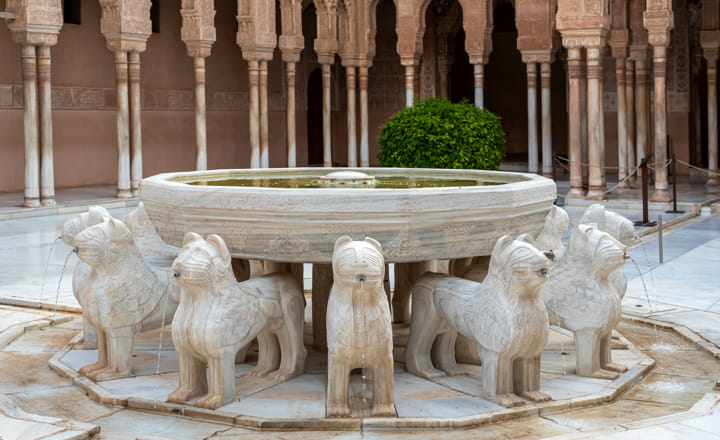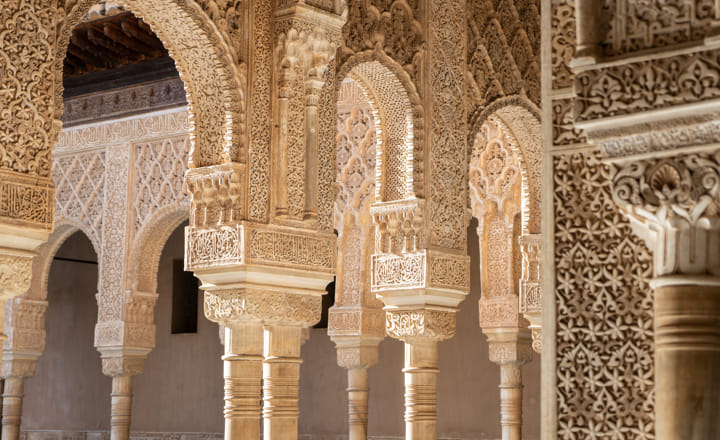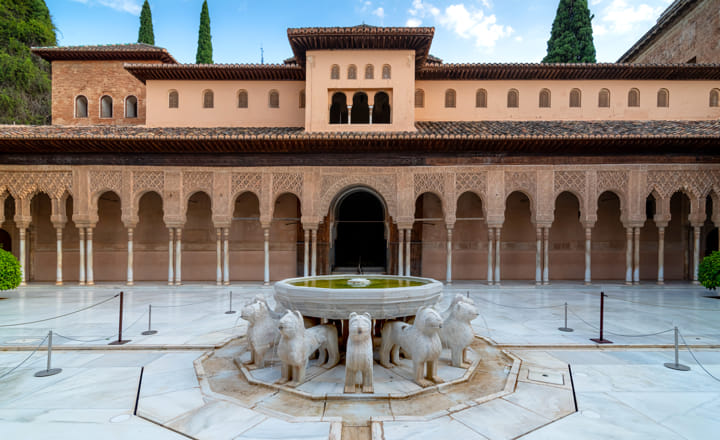The Court of the Lions of the Alhambra of Granada is one of the most visited places and captures all our attention as soon as we enter. Also known as the Palace of the Riyadh al Said, it is located in the center of the fortified enclosure.
Without a doubt, it is one of the things to do and see in Granada when visiting the monument. If you are planning to visit the most important Moorish fortress in Andalusia, do not hesitate to do so with specialized guides who know the curiosities of the Court of the Lions and the citadel such as Granada a Pie. But if you want to know a little more, read on.
What does the most famous courtyard of the Alhambra in Granada represent?
The Court of the Lions has a central fountain surrounded by lions, a symbol that does not represent Arab times, but does represent Roman times.
The fountain is crowned with 12 lions representing the signs of the zodiac. During the time, the fountain was a way to demonstrate the power of the sultan and also refers to the life and four rivers of the paradise of the Qur’an. The ends of the lions’ courtyard are arranged according to the cardinal points.
What is the origin of its name?
It was founded at the end of the 14th century by Mohammed V, according to Arab researchers the origin of its name comes from the Sea of Bronze, a source described in the Bible. Although its name actually refers to the 12 white marble lions of Macael.

Are there differences between lions?
Although at first glance they may seem similar, one of the curiosities of the Court of the Lions is that they are different from each other. You only have to look at the features of their coat, their jaws and even the alert posture, teeth and ears. Moreover, two lions have a triangle engraved on their foreheads as a symbol of the tribe of Judah and Levi.
What does the Court of the Lions represent?
Among the curiosities of the Court of the Lions we cannot omit the fact that it is really unknown what these sculptures refer to. As we mentioned earlier, it represents the signs of the zodiac.
Although there are scholars who think that it belongs to the twelve tribes of Israel linked to the twelve sons that Jacob had, hence the engravings on the foreheads of some lions. They are also thought to simulate the paradise of the Qur’an, citing the origin of life with the four rivers.
On the other hand, after several investigations, it is believed that the lions are original to the house of the Jewish poet Yusuf Ibn Nagrela, although it is unknown if they were built during his lifetime or after.
Design of the courtyard and Fountain of the Lions
The structure of this place follows a transept design with proportions that give great architectural value to the courtyard. Of particular note are the arches of the Court of the Lions with the Hall of the Abencerrajes and the Hall of the Two Sisters, where the rooms of the Sultan’s wife can be seen.
It is a rectangular enclosure, surrounded by 124 white marble columns with fine shafts. The columns support cubic capitals and abacus decorated with inscriptions.

The Fountain of the Lions is not unique in Granada
Due to the popularity and large number of visitors to the Muslim fortress of Granada, known for its famous Fountain of the Lions, several replicas of this fountain have been built in different parts of Spain. An example of this is the replica located in the village of Macael, in Almería.
The tourist promotion of the Fountain of the Lions is such that we can not only see it in Granada, but it has also appeared in films and short films.
Curiosities of the Court of the Lions, an engraved poem
Inside the fountain cup is an engraved poem by Ibn Zamrak. Although in the seventeenth century a new bowl would be added to complete the text. It is located in the garden of the Adarves.
Was there a garden next to the Fountain of the Lions?
Numerous investigations have led to the belief that the center of the courtyard was a low garden, where its lung would be the Fountain of the Lions itself. It would be adorned with white marble galleries and six planted orange trees. Currently, we can only see the marble tiles, since the garden was removed to avoid dampness and damage to the patio.

